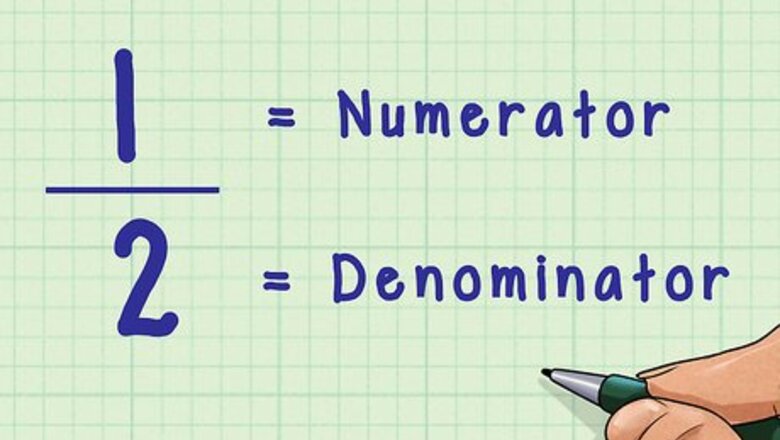
views
Adding Fractions With Common Denominators
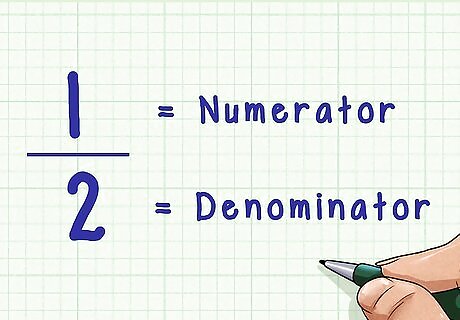
Recognize the numerator and denominator. There are two parts to all fractions: the numerator, which is the number above the line, and the denominator, which is the number below the line. While the denominator tells you how many parts a whole has been broken into, the numerator tells you how many pieces of that whole there are. In the fraction ½, for instance, the numerator = 1 and the denominator = 2, and the fraction is one-half.
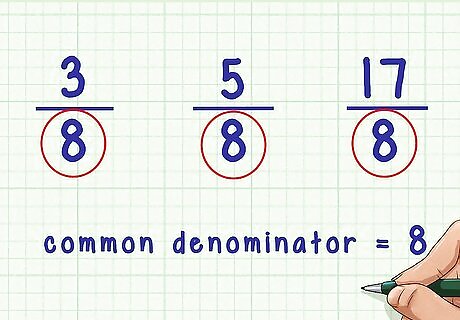
Determine the denominator. When two or more fractions have a common denominator, it means they all have the same number as a denominator, or that they all represent wholes that have been broken into the same number of pieces. Fractions with a common denominator can be added together very easily, and the resulting fraction will have the same denominator as the original fractions. For instance: The fractions 3/5 and 2/5 have a common denominator of 5. The fractions 3/8, 5/8, and 17/8 have a common denominator of 8.
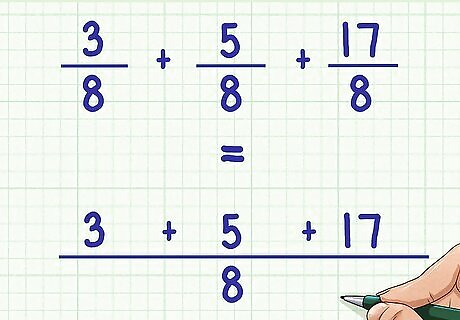
Locate the numerators. To add fractions together when they have a common denominator, you simply add all the numerators together and rewrite the sum over the original denominator. In the fractions 3/5 and 2/5, the numerators are 3 and 2. In the fractions 3/8, 5/8, and 17/8, the numerators are 3, 5, and 17.
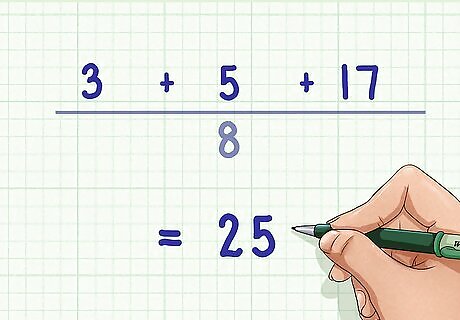
Add the numerators. In the example of 3/5 + 2/5, add the numerators 3 + 2 = 5. In the example 3/8 + 5/8 + 17/8, add the numerators 3 + 5 + 17 = 25.
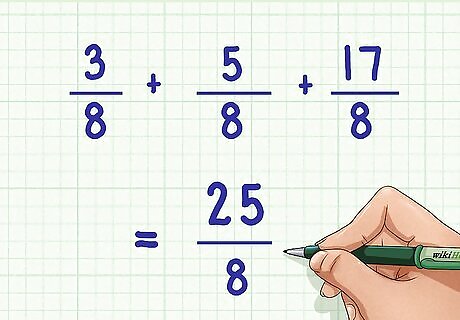
Rewrite the fraction with the new numerator. Remember to use the same common denominator, since the number of parts that the whole is divided into remains the same, and you are just adding the number of individual pieces. The fractions 3/5 + 2/5 = 5/5 The fractions 3/8 + 5/8 + 17/8 = 25/8

Solve the fraction if necessary. Sometimes a fraction can be put into simpler terms, and this includes dividing it to get a number that’s not a fraction or decimal. In the example 5/5, this fraction can be solved easily because any fraction where the numerator and denominator are the same will equal 1. Think about it like a pie that’s been cut into three pieces. If you eat all three pieces of the pie, then you’ve eaten one whole pie. Any fraction can be converted from a fraction by dividing the numerator by the denominator, and you’ll often end up with a decimal number. For instance, 5/8 can also be written as 5 ÷ 8, which equals 0.625.

Reduce the fraction if you can. A fraction is said to be in its simplest form when both the numerator and the denominator don’t have any common factors they can be divided by. For instance, in the fraction 3/6, both the numerator and denominator have a common factor of 3, meaning they can both be divided by 3 to produce a whole number. Therefore, the fraction 3/6 can be thought of as 3 ÷ 3 / 6 ÷ 3 = ½. EXPERT TIP Joseph Meyer Joseph Meyer Math Teacher Joseph Meyer is a High School Math Teacher based in Pittsburgh, Pennsylvania. He is an educator at City Charter High School, where he has been teaching for over 7 years. Joseph is also the founder of Sandbox Math, an online learning community dedicated to helping students succeed in Algebra. His site is set apart by its focus on fostering genuine comprehension through step-by-step understanding (instead of just getting the correct final answer), enabling learners to identify and overcome misunderstandings and confidently take on any test they face. He received his MA in Physics from Case Western Reserve University and his BA in Physics from Baldwin Wallace University. Joseph Meyer Joseph Meyer Math Teacher To simplify fractions, you can divide both the numerator and denominator by a common factor. This creates a new, easier-to-use fraction with smaller components, but it represents the same value. For instance, if you divide both the numerator and denominator of 6/12 by 2, you get 3/6, which is equal to 1/2.
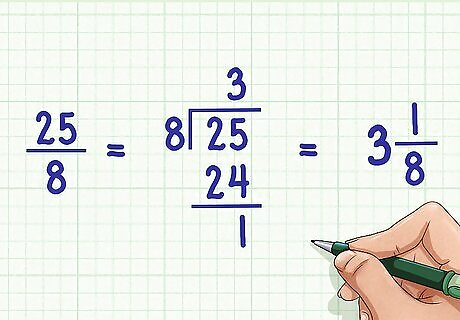
Convert improper fractions to mixed numbers if necessary. When a fraction has a numerator that’s bigger than the denominator, such as 25/8, this is said to be an improper fraction (the reverse, when the numerator is smaller than the denominator, is a proper fraction). These can be converted into a mixed number, which is a number that has a whole number plus a proper fraction. To convert an improper fraction like 25/8 to a mixed number, you: Divide the improper fraction’s numerator by its denominator to determine how many whole times 8 goes into 25, where the answer is 25 ÷ 8 = 3(.125) Determine what’s left over. If 8 x 3 = 24, subtract that from the original numerator: 25 – 24 = 1, where the difference is the new numerator. Rewrite the mixed number. The denominator will be the same from your original improper fraction, meaning 25/8 can be rewritten as 3 1/8.
Subtracting Fractions With Common Denominators
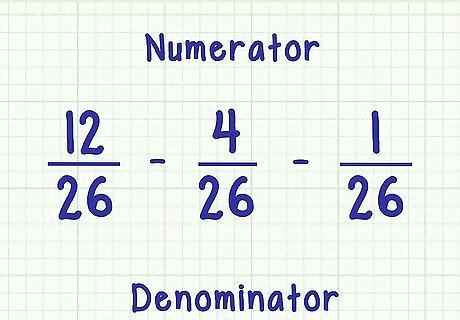
Locate the numerators and denominators. For instance, look at the equation 12/26 – 4/26 – 1/26. In this example: The numerators are 12, 4, and 1 The common denominator is 26
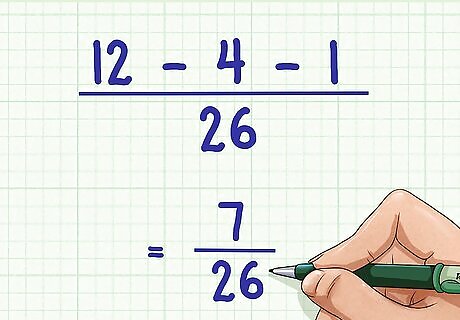
Subtract the numerators. Like with addition, you don’t have to worry about doing anything to the denominator, so just find the difference between the numerators: 12 – 4 – 1 = 7 Rewrite the fraction with the new numerator. 12/26 – 4/26 – 1/26 = 7/26.
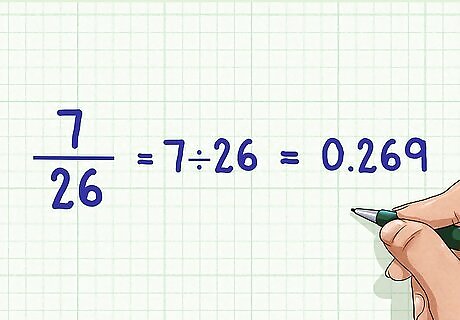
Reduce or solve the fraction if necessary. Similar to adding fractions, when you subtract fractions you can still end up with: An improper fraction that can be converted to a mixed number A fraction that can be solved through division A fraction that can be put into a simpler form by finding a common denominator.
Finding a Common Denominator

Locate the denominators. Fractions don’t always have the same denominators, and in order to add or subtract those fractions, you must first find a common denominator. To start, locate the denominators in the fractions you’re dealing with. For instance, in the equation 5/8 + 6/9, the denominators are 8 and 9.
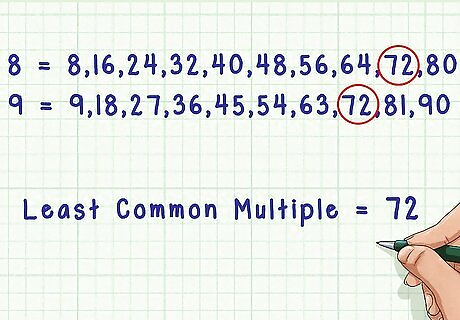
Determine the least common multiple. To find a common denominator, you need to find the least common multiple of the two numbers, which is the smallest positive number that’s a multiple of both original numbers. To find the least common multiple of 8 and 9, you must first go through the multiples of each number: The multiples of 8 are: 8, 16, 24, 32, 40, 48, 56, 64, 72, 80, 88, 96, 104, etc. The multiples of 9 are: 9, 18, 27, 36, 45, 54, 63, 72, 81, 90, 99, 108, etc. The least common multiple of 8 and 9 is 72.
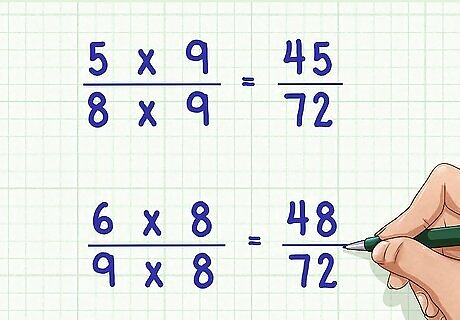
Multiply the fractions to achieve the least common multiple. Multiply each denominator by the correct number to achieve the common denominator. Remember that whatever you do to each denominator, you must also do to its numerator. For the fraction 5/8: to achieve the common denominator of 72, you multiply 8 x 9. Therefore, you must also multiply the numerator by 9, giving you 5 x 9 = 45 For the fraction 6/9: to achieve the common denominator of 72, you multiply 9 x 8. Therefore, you must also multiply the numerator by 8, giving you 6 x 8 = 48
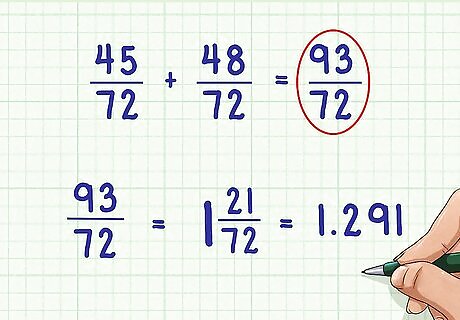
Rewrite the fractions. The new fraction will have the common denominator and the product of the numerators multiplied by the same values: The fraction 5/8 becomes 45/72, and the fraction 6/9 becomes 48/72. Since they now have a common denominator, you can add the fractions 45/72 + 48/72 = 93/72. Don’t forget to reduce, solve, or convert improper fractions to mixed numbers when applicable and necessary.














Comments
0 comment